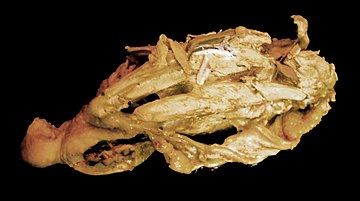The European Union's Animal By-Products Regulations (Regulation No 1069/2009) allows for the treatment of some animal by-products in composting and biogas plants ( anaerobic digesters). The following article describes procedures required to allow solid outputs ( compost, digestate) from composting plants and anaerobic digesters onto land in the United Kingdom.

Categories of Animal By-Products
- Category 1: Very high risk
- Category 2: High risk
- Category 3: Low risk
Category 1
- BSE ( Bovine spongiform encephalopathy) carcasses and suspects
- Specified Risk Material
- Catering waste from international transport
Must all be destroyed, not for use in composting or biogas plants
Category 2
Can be used in composting and biogas plants after rendering (133C, 3 bar pressure) Manure and gut contents only can be used after pretreatment
Category 3
- Catering waste from households, restaurants
- Former food
- Much slaughter house waste e.g. waste blood & feathers
Can be used in composting and biogas plants without pretreatment
Treatment Standards
Composting
Closed reactor
- Maximum particle size 40cm, minimum temperature 60C, minimum time at that temperature 2 days
- Maximum Particle size 6cm, minimum temperature 70C, minimum time at that temperature 1 hour
Housed windrow
- Particle size 40cm, minimum temperature 60C, minimum time at that temperature 8 days
Biogas plants
- Maximum particle size 5cm, minimum temperature 57C, minimum time at that temperature 5 hours
- Maximum particle size 6cm, minimum temperature 70C, minimum time at that temperature 1 hour
References
Notes
Further reading
- Leoci, R., Animal by-products (ABPs): origins, uses, and European regulations, Mantova: Universitas Studiorum, 2014. ISBN 978-88-97683-47-6